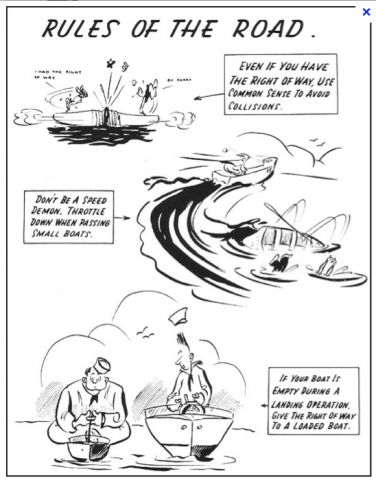When you are offshore passage making on a yacht there are many course factors you need to take into account.
By observing the Col Regs you have a good chance of transiting without hassle .
Below are the rules you need to know.
Collision Risks to Off-Shore Yachts
The purpose of this Marine Notice is to reinforce
to masters, officers of the watch and all seafarers,
including yacht crew, their obligations to avoid
collisions in accordance with the International
Regulations for Preventing Collisions at Sea 1972
(COLREG). This can be found in Marine Orders
Part 30 – Avoidance of Collisions.
In particular all masters, officers of the watch
and seafarers are alerted to the risks of collision
between off-shore yachts and commercial trading
vessels when yachts voyage in the vicinity of
commercial shipping lanes.
In this regard Rule 18 of the COLREGs prescribes
that a power driven vessel underway shall keep out
of the way of a sailing vessel. This presumes that
the power driven vessel can see the sailing vessel
(either by visual means or radar), is able to develop
a Closest Point of Approach assessment and, if
necessary, can take the appropriate avoiding action.
However, Rule 2 – Responsibility – states generally
that:
(a) Nothing in these Rules shall exonerate any
vessel, or the owner, master or crew thereof,
from the consequences of any neglect to
comply with these Rules or of the neglect of
any precaution which may be required by the
ordinary practice of seamen, or by the special
circumstances of the case.
(b) In construing and complying with these Rules
due regard shall be had to all dangers of
navigation and collision and to any special
circumstances, including the limitations of
the vessels involved, which may make a
departure from these Rules necessary to avoid
immediate danger.
Rule 9 (b) says a vessel of less than 20 metres
in length or a sailing vessel shall not impede the
passage of a vessel which can safely navigate only
within a narrow channel or fairway.
Rule 10 (j) says a vessel of less than 20 metres
in length or a sailing vessel shall not impede the
safe passage of a power-driven vessel following a
traffic lane.
Rule 18 (d) also says that any vessel other than a
vessel not under command or a vessel restricted in
her ability to manoeuvre shall, if the circumstances
of the case admit, avoid impeding the safe passage
of a vessel constrained by her draught, exhibiting
the signals in the Rules.
Yachts also need to be aware of the risk of collision,
by day or by night, with anchored vessels.
Overall, although a trading vessel may be required
to take avoiding action in certain circumstances,
the skippers of yachts need to be aware that
investigations into collisions between commercial
trading vessels and yachts, both in Australia
and overseas, repeatedly show that yachts are
extremely difficult to see from the bridge of a major
vessel in some circumstances. Factors contributing
to this difficulty include:
•
Yachts are usually painted white, or light pastel
colours, and merge with the seascape;
•
Yachts make poor radar targets due to their
construction and size;
•
Yachts frequently do not maintain a steady
course and make unexpected course alterations;
and
•
At night the lights prescribed by the COLREGs
for yachts (small yachts in particular) have very
limited visual range – as little as one mile for
yachts of less than 12 metres length over all.
As a result, yachts should not presume that they
can be seen by an approaching vessel and should
act accordingly.
Additional exacerbating factors are that:
•
Large vessels can not alter course or reduce
speed quickly;
•
The visual lookout from yachts, particularly in
a seaway, is often poor; and
•
In confined waters, harbour channels or some
designated routes (the Inner Route of the Great
Barrier Reef for example); large vessels can
not deviate from their intended course without
engendering the risk of grounding.
As a result, officers of the watch on large vessels,
and all crew aboard yachts are encouraged to
exercise caution in circumstances where large
vessels and yachts might be at close quarters.
Some simple precautions recommended for yachts
on coastal voyages are:
•
Keep a good visual and radar lookout;
•
Avoid recognised shipping routes where at all
possible;
•
Fit and activate a radar reflector, an anti-collision
radar transponder or radar target enhancer;
•
Fit and utilise AIS;
•
Maintain a listening watch on VHF Channel 16;
•
Do not make unexpected course alterations
when in the vicinity of other vessels; and
•
Do not impede large vessels that have restricted
room to manoeuvre
Yachts should also carry a registered 406 MHz
EPIRB (GPS enabled version is recommended)
and marine radios, have an agreed contact
schedule and make details of their intended voyage
available to their emergency contacts for use
should the need arise.
